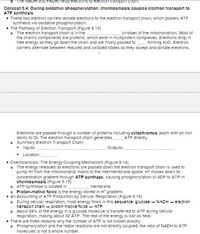
Human Anatomy & Physiology (11th Edition)
11th Edition
ISBN: 9780134580999
Author: Elaine N. Marieb, Katja N. Hoehn
Publisher: PEARSON
expand_more
expand_more
format_list_bulleted
Question
option are
- chemiosmosis
- NADH, FADH2, and O2
- ATP synthase
- Proton-motive force
- NAD+, FAD and H2O

Transcribed Image Text:Concept 9.4: During oxldative phosphorylation, chemlosmosis coupies ciectron transport to
ATP synthesis
• These two eiectron carriers donate electrons to the electron transport chain, which powers ATP
synthesis via oxidative phosphorylation.
• The Pathway of Electron Transport (Figure 8.13)
- The electran transport chain is in the
the chain's components are protelns, which exist in multiproten complexes. Electrons drop in
tree energy as they go down the chain and are finaly passed to
carriers aternate between reduced and axidized states as they accept and donate electrons.
(cristae) of the mitochondrion. Most of
forming H;0. Electran
Electrons are passed through a number of proteins ncluding cytochromes (each with an iron
atom) to O2. The electron transport chain generates
: Bummary Electron Transport Chain
• rputs
ATP directy.
Outputs:
Location:
• Chemiasmosis: The Energy-Coupling Mechanism (Figure 3.14)
- The energy released as electrons are passed down the electron transport chain Iis used to
pump H- trom the mitochondrial matrix to the Intermembrane space. H moves down ts
concentration gradient through ATP synthase, causing phosphorylation of ADP to ATP in
chemlosmosis (Rigure 9.15).
= ATP synthase is iocated in
: Proton-mative toree is the energy stored in H gradent.
• An Accounting of ATP Production by Cellular Respiraton (Figure 9.16)
- During celluiar respiration, most energy tlows in this sequence glucose - NADH – electron
transport chain - proton-motive force - ATP
- About 34% at the energy ina glucose molecule is transferred to ATP during celular
respration, making about 32 ATP. The rest ot the energy is lost as heat.
• There are three reasons why the number of ATP Is not known exacty.
: Phosphorylation and the redox reactions are not directiy coupled; the ratio of NADH to ATP
membrane.
molecules is not a whole number.
![Question 6
Review Concept 9.4. Match the term and its description. Each term can only be used once.
electron transport chain inputs
[ Choose ]
This protein functions in phosphorylation of ADP to ATP.
[ Choose 1
An energy coupling mechanism that use the energy released as hydrogen across a
[ Choose 1
membrane to synthesis ATP
Energy stored in H+ gradient is
| Choose](https://content.bartleby.com/qna-images/question/28a22340-6d9d-4cc4-a9c4-adb517e05df3/8a59a83c-53b8-4404-a369-895321f4c0ac/aag5pnq_thumbnail.jpeg)
Transcribed Image Text:Question 6
Review Concept 9.4. Match the term and its description. Each term can only be used once.
electron transport chain inputs
[ Choose ]
This protein functions in phosphorylation of ADP to ATP.
[ Choose 1
An energy coupling mechanism that use the energy released as hydrogen across a
[ Choose 1
membrane to synthesis ATP
Energy stored in H+ gradient is
| Choose
Expert Solution
This question has been solved!
Explore an expertly crafted, step-by-step solution for a thorough understanding of key concepts.
This is a popular solution
Trending nowThis is a popular solution!
Step by stepSolved in 2 steps

Knowledge Booster
Similar questions
- Use the shapes tool to outline the following: ETC in Blue Matata NADH Proton gradient in Red Electron Carriers in Green. ATP Synthase in Yellow FACH Pre-work 1 NAD Oxydative Phosphorylation FAD 2H² + 1/20 ⒸW.Y. Sunshine / Shutterstockarrow_forwardA cell is grown on minimal media containing only 3-phosphoglyceric acid as a source of carbon and energy. What is the most likely place this compound would enter the metabolic cycle? O Glycolysis O Conversion of Pyruvate to Acetyl-CoA O The TCA Cycle The Electron Transport Chainarrow_forwardThere are two different phosphofructokinase enzymes, PFK and PFK2. Which makes a product that goes forward in glycolysis? O PEK O Neither O Both O PFK2arrow_forward
arrow_back_ios
arrow_forward_ios
Recommended textbooks for you
 Human Anatomy & Physiology (11th Edition)BiologyISBN:9780134580999Author:Elaine N. Marieb, Katja N. HoehnPublisher:PEARSON
Human Anatomy & Physiology (11th Edition)BiologyISBN:9780134580999Author:Elaine N. Marieb, Katja N. HoehnPublisher:PEARSON Biology 2eBiologyISBN:9781947172517Author:Matthew Douglas, Jung Choi, Mary Ann ClarkPublisher:OpenStax
Biology 2eBiologyISBN:9781947172517Author:Matthew Douglas, Jung Choi, Mary Ann ClarkPublisher:OpenStax Anatomy & PhysiologyBiologyISBN:9781259398629Author:McKinley, Michael P., O'loughlin, Valerie Dean, Bidle, Theresa StouterPublisher:Mcgraw Hill Education,
Anatomy & PhysiologyBiologyISBN:9781259398629Author:McKinley, Michael P., O'loughlin, Valerie Dean, Bidle, Theresa StouterPublisher:Mcgraw Hill Education, Molecular Biology of the Cell (Sixth Edition)BiologyISBN:9780815344322Author:Bruce Alberts, Alexander D. Johnson, Julian Lewis, David Morgan, Martin Raff, Keith Roberts, Peter WalterPublisher:W. W. Norton & Company
Molecular Biology of the Cell (Sixth Edition)BiologyISBN:9780815344322Author:Bruce Alberts, Alexander D. Johnson, Julian Lewis, David Morgan, Martin Raff, Keith Roberts, Peter WalterPublisher:W. W. Norton & Company Laboratory Manual For Human Anatomy & PhysiologyBiologyISBN:9781260159363Author:Martin, Terry R., Prentice-craver, CynthiaPublisher:McGraw-Hill Publishing Co.
Laboratory Manual For Human Anatomy & PhysiologyBiologyISBN:9781260159363Author:Martin, Terry R., Prentice-craver, CynthiaPublisher:McGraw-Hill Publishing Co. Inquiry Into Life (16th Edition)BiologyISBN:9781260231700Author:Sylvia S. Mader, Michael WindelspechtPublisher:McGraw Hill Education
Inquiry Into Life (16th Edition)BiologyISBN:9781260231700Author:Sylvia S. Mader, Michael WindelspechtPublisher:McGraw Hill Education

Human Anatomy & Physiology (11th Edition)
Biology
ISBN:9780134580999
Author:Elaine N. Marieb, Katja N. Hoehn
Publisher:PEARSON

Biology 2e
Biology
ISBN:9781947172517
Author:Matthew Douglas, Jung Choi, Mary Ann Clark
Publisher:OpenStax

Anatomy & Physiology
Biology
ISBN:9781259398629
Author:McKinley, Michael P., O'loughlin, Valerie Dean, Bidle, Theresa Stouter
Publisher:Mcgraw Hill Education,

Molecular Biology of the Cell (Sixth Edition)
Biology
ISBN:9780815344322
Author:Bruce Alberts, Alexander D. Johnson, Julian Lewis, David Morgan, Martin Raff, Keith Roberts, Peter Walter
Publisher:W. W. Norton & Company

Laboratory Manual For Human Anatomy & Physiology
Biology
ISBN:9781260159363
Author:Martin, Terry R., Prentice-craver, Cynthia
Publisher:McGraw-Hill Publishing Co.

Inquiry Into Life (16th Edition)
Biology
ISBN:9781260231700
Author:Sylvia S. Mader, Michael Windelspecht
Publisher:McGraw Hill Education